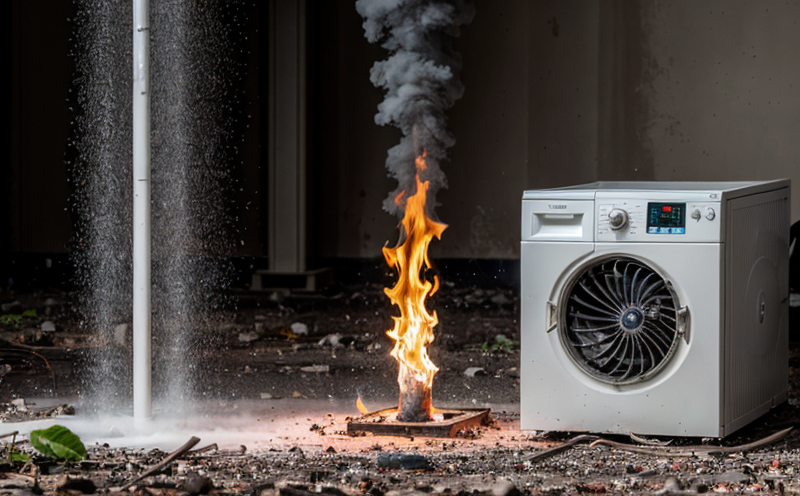IEC 63330 Environmental Stress Testing of UAV Lithium-Ion Batteries
The International Electrotechnical Commission (IEC) has developed IEC 63330, a standard specifically designed to assess the robustness and reliability of lithium-ion batteries used in unmanned aerial vehicles (UAVs). This testing protocol is crucial for ensuring that UAV batteries can withstand various environmental stresses without failure. The standard covers a range of tests including thermal cycling, vibration, shock, humidity, altitude, and low pressure conditions.
The primary purpose of IEC 63330 is to provide a comprehensive set of procedures that simulate real-world operational conditions for UAV batteries. This ensures that manufacturers can produce reliable and safe products that meet stringent quality standards. By subjecting the batteries to these environmental stresses, engineers gain insights into potential weaknesses or areas requiring improvement in battery design.
Thermal cycling tests are conducted to evaluate how well the battery performs under extreme temperature changes. Vibration testing assesses the resilience of the battery against mechanical stress caused by motion and impact. Shock tests determine whether the battery can withstand sudden, sharp impacts without damage. Humidity and altitude testing help identify if the battery functions correctly in high humidity environments at different altitudes. Low pressure conditions are also simulated to ensure the battery operates efficiently under reduced atmospheric pressure.
The testing process is meticulous and involves precise control over environmental variables such as temperature, humidity, and air pressure. Specimen preparation includes charging the batteries according to manufacturer specifications before placing them into the test chambers designed to simulate specific stress conditions. Instrumentation used during these tests includes data loggers for recording temperature, voltage, current, and other relevant parameters.
After each stress test, thorough inspections are performed on the batteries to identify any signs of damage or degradation. Acceptance criteria vary depending on the specific requirements set forth by IEC 63330 but generally involve checking for intact casing integrity, consistent electrical performance metrics like voltage and capacity, and adherence to safety standards.
Understanding these parameters is essential because they directly impact the overall performance and longevity of UAV batteries. For instance, maintaining proper voltage levels throughout prolonged usage periods ensures efficient flight times while minimizing risks associated with undercharging or overcharging.
Manufacturers who comply with IEC 63330 not only enhance their product quality but also demonstrate commitment to safety standards which are increasingly important in the rapidly growing UAV industry. Compliance helps build customer trust and opens doors for international markets where stringent regulatory requirements apply.
In summary, IEC 63330 Environmental Stress Testing provides a robust framework for evaluating UAV lithium-ion batteries' resilience against various environmental challenges faced during operation. This testing method ensures that manufacturers produce reliable products capable of meeting high performance expectations while maintaining safety standards.
Applied Standards
| Standard | Description |
|---|---|
| IEC 63330 | This standard defines the procedures for environmental stress testing of UAV lithium-ion batteries, including thermal cycling, vibration, shock, humidity, altitude, and low pressure conditions. |
| ISO/IEC Guide 149:2015 | An international guide providing general requirements for quality management systems which are essential for ensuring consistent compliance with environmental stress testing protocols. |
| ASTM D7396-18 | American Society for Testing Materials standard that specifies practices for thermal cycling tests, which complement the IEC 63330 requirements by providing additional details on maintaining controlled temperature environments during testing. |
| EN 50247:2015 | This European norm sets out guidelines for measuring and controlling humidity levels within test chambers, ensuring accurate replication of real-world conditions encountered by UAV batteries in various regions around the globe. |
Benefits
The implementation of IEC 63330 Environmental Stress Testing offers numerous advantages for manufacturers, quality managers, compliance officers, and R&D engineers involved in UAV battery development.
Firstly, it enhances product reliability by identifying potential weaknesses early on in the design phase. Secondly, complying with this standard strengthens brand reputation among consumers who value safety and durability when choosing UAV products. Thirdly, it facilitates easier entry into international markets where stringent environmental regulations are enforced. Fourthly, it improves operational efficiency by reducing downtime due to faulty batteries during critical missions.
By adhering to IEC 63330, companies can ensure consistent quality across all production batches, thereby increasing customer satisfaction and loyalty. Moreover, successful completion of these rigorous tests provides valuable data that contributes to ongoing improvements in UAV battery technology.
Environmental and Sustainability Contributions
The IEC 63330 Environmental Stress Testing plays a vital role in promoting environmental sustainability within the UAV industry. By ensuring that UAV batteries are capable of withstanding harsh environmental conditions, this testing contributes to minimizing waste generation associated with frequent replacements caused by failure under adverse circumstances.
Additionally, compliance with these standards promotes resource efficiency since manufacturers can design more durable and longer-lasting batteries. This reduces the need for continuous manufacturing processes aimed at replacing short-lived products, thus conserving raw materials and energy resources.
The data collected from IEC 63330 testing also supports research initiatives focused on developing greener alternatives to traditional lithium-ion batteries. Such efforts aim to reduce the environmental footprint of UAVs by exploring more sustainable power sources that are less harmful to ecosystems.





